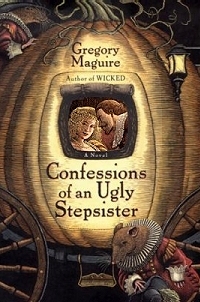 Synopsis:
Synopsis:
Confessions of an Ugly Stepsister is author Gregory Maguire’s reworking of a children’s classic, Cinderella. But Maguire’s reinvention of the tale bears little resemblance to that or any other version. He asked — and answered — the questions that few, if any, thought to ask. It is assumed that the wicked stepmother was motivated purely by jealousy of Cinderella’s beauty when her own daughters were so homely and, by society’s standards, undesirable. But did something even more sinister fuel her mistreatment of her stepdaughter?
And what about Cinderella’s father? Why did he choose the stepmother as his wife? Couldn’t he see her petty, vindictive nature or was he blind to her true character?
Maguire places the story in seventeenth-century Haarlem, Holland, where recently widowed Margarethe and her two daughters seek shelter with an eccentric painter — the Master and his assistant, Caspar. The Master creates two contrasting types of paintings — those accepted by society (“Annunciations and Lamentations and Nativities; . . . And patrons, in their holiest of aspects.”) and his depictions of those to whom life has been less than kind, such as the Queen of the Hairy-Chinned Gypsies, that he keeps hidden away in his Gallery of God’s Mistakes.
In the lives of children, pumpkins can turn into coaches, mice and rats into human beings. When we grow up, we learn that it’s far more common for human beings to turn into rats.
When, as an act of charity, the Master takes them in, Margarethe runs the Master’s house, while her daughters, Ruth and Iris, are assigned chores in exchange for their room and board. Ruth, mute and with “a withered arm,” is to gather wildflowers for the Master’s studio each morning as it is believed she is capable of doing nothing more. Obese and clumsy, her own mother calls her an “ox.” Iris, her younger caregiver and protector, is tall, thin and extremely plain, but is assigned to sit silently for hours on end so that the Master can create a portrait of her. The result, Ugly Girl with Wildflowers, changes all of their fortunes.
Clara van den Meer is a beautiful yet mysterious child with golden hair. Never allowed out into the world, she remains safely at home with her mother, Henrika.
All of their lives become entangled when Heer van den Meer visits the Master’s studio to view his paintings. There, he discovers that Iris can speak both Dutch and English. Desirous of a painting, as well as a companion for Clara who can teach her to speak English, van den Meer commissions the Master to create a portrait of the beautiful Clara with tulips, through which “[t]here are fortunes to be made, there is slow recovery from the endless wars with Spain to be achieved, there is a place for all of us in the good times ahead, . . .”
When Margarethe declares, “Give me room to cast my eel spear, and let follow what may,” can van den Meer’s predictions prove to be accurate?
Review:
Although his is a very different version of the story, Maguire’s writing is as lyrical as the classic Rodgers and Hammerstein score for Cinderella. His prose has a unique rhythm that pulls the reader into the story, holding you spellbound and curious, beginning with the first-person prologue:
Nothing in my childhood was charming. What fortune attended our lives was courtesy of jealousy, greed, and murder. And nothing in my childhood was charmed. Or not that I could see at the time. If magic was present, it moved under the skin of the world, beneath the ability of human eyes to catch sight of it.
Besides, what kind of magic is that, if it can’t be seen?
Maguire explores the perception and impact of beauty from the vantage point of several characters. There is, of course, Clara, whom all agree is an exquisite child, but for whom “[e]xtreme beauty is an affliction . . .” There is the Master, who creates paintings of beautiful persons and objects that are commercially viable, but hides away his artistic impressions of lives lived at the opposite end of the spectrum, so physically grotesque that he deems them “God’s Mistakes.” There is van den Meer who sees tulips not merely as beautiful creations of nature, but a means to secure a fortune for himself and his family. Margarethe initially seeks beauty in the form of charity for herself and her daughters, but after receiving it reveals herself to be even more envious of others — not just Clara — than we ever knew the evil stepmother could be. Her capacity for greed and corruption is limitless. As for Ruth, she is either ignored or viewed as a liability by those around her, dispatched to gather wildflowers but assumed to be incapable of appreciating their beauty or much else. Her feelings about the events that unfold around her are not even an afterthought for the other characters.
And then there is Iris, the main character in this retelling. Iris’ imagination convinces her that an imp (a little devil or demon) lives in the van den Meer house and determines the fate of its residents. She contemplates whether Clara is really a changeling, as she claims. Eventually, the Master encourages her to become his apprentice because, although she lacks physical beauty, she is intelligent and astute, and he believes in her ability to see all of the world’s grandeur and foibles. The Master is certain that she will be able to recreate and translate what she observes on canvas. But Maguire explores whether Iris — out of all of Maguire’s characters — does see the world as it really is.
There is nothing more delightful than having absolutely no idea what twists and turns a story is going to take. Confessions of an Ugly Stepsister is not only charming, it is intriguing and completely unpredictable.
Eventually, the prince makes his appearance, and there is a slipper that fits neither Ruth nor Iris. But ultimately, this story is not about just about finding one’s true love and living happily ever after. It is about vision: How the characters envision themselves, the way their self-perception is alike or different from the way others see them, and the resultant impact on their fortunes. It is about the ability to envision a life beyond one’s current circumstances and how one goes about tranforming that vision into reality. Most importantly, it is about the way we see both the world around us and those we love. Is that which is as “plain as the nose on [our] face” always that obvious? Or are we so preoccupied with our own ambition that we often fail to observe and react to much of what is happening right before us? Is the old adage — “things are never truly what they seem” — true?
This is not a light-hearted fairy tale. Set against the historically accurate backdrop of a country besieged by poverty and the plague, it is as much a morality tale as any classic Greek myth or Shakespearian play. As you read the final chapter, you will assess your own perceptions of the characters and observations of their actions. You might be very surprised by what you learn about your own capacity to observe and interpret what is happening on the pages right in front of you. I emphatically recommend Confessions of an Ugly Stepsister if you want to be both entertained and challenged to think about the way in which you define and perceive beauty, integrity, and self-fulfillment — and how far you would go to achieve your goals.



10 Comments
[New Post] Book Review: Confessions of an Ugly Stepsister https://www.jhsiess.com/2010/05/15/book-r…
My sister loves Maguire’s books, but I struggled through the two I read, so I’ve given up on them.
I had a difficult time with sections of the book Wicked — but the musical is one of my family’s all time favorites!!
I have not given up on Maguire, however, and have Confessions of an Ugly Step-Sister sitting on my shelf. I may even try to read it in time for Carl’s Once Upon a Time reading challenge 🙂
.-= Molly´s last blog . . . Time to Relax….. =-.
Sounds like by the time he’s done, there isn’t much Cinderella left in the book.
.-= Alice Audrey´s last blog . . . Welcome, Ann Pino =-.
“queen of the hairy chinned gypsies” lol lol I laughed quite hard when I read that!
Nice blog and review…Haven’t read any of this authors books, but have heard mixed reviews on them..you either love them or don’t get them! LOL
Allison
If you have time..stop by my blog!!
http://allisonsatticblog.blogspot.com
.-= Allison´s last blog . . . Book Giveaway Winner!!! =-.
I enjoy how Maguire really takes his stories to another level and not just another perspective on the familiar tale.
.-= Elizabeth´s last blog . . . Giveaway & Review: Leaving Unknown by Kerry Reichs =-.
Have you read any of the original Oz books? Way better than the movie. 🙂
Pingback: Welcome to the 46th Book Review Blogger Carnival « Nishita's Rants and Raves
I did not enjoy Wicked (love the musical, though!), but this one sounds like one I should give a try. I love fairy tale retellings.